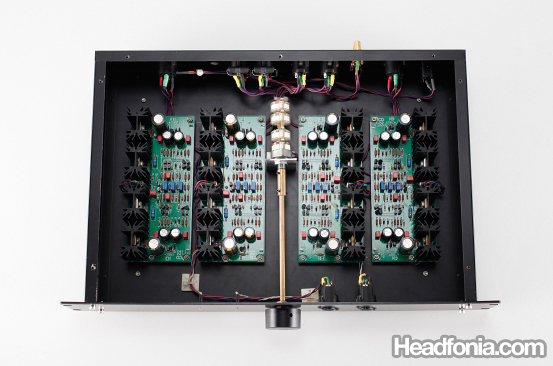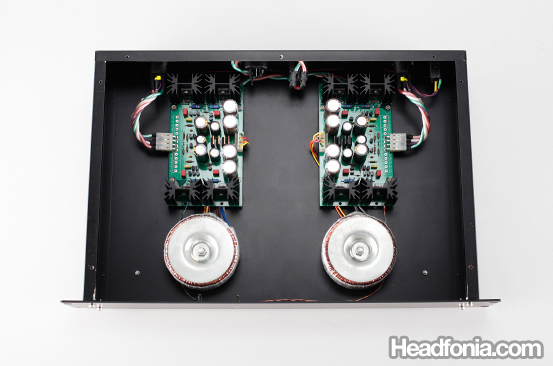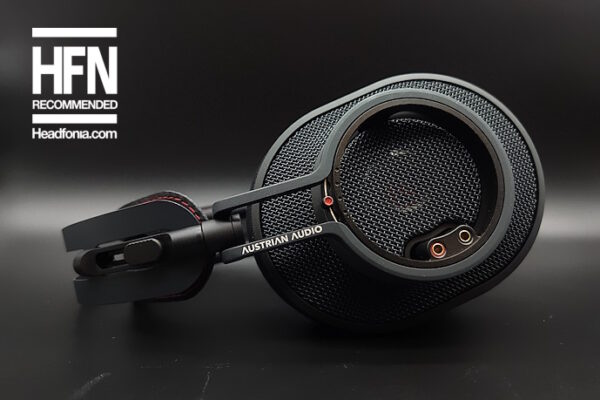The Sound
The main reason that I’m writing this article is to provide some thoughts about how the Beta22 actually sounds, as articles outlining the Beta22’s sound character is fairly rare.
If there is one thing that the Beta22 is famous for, it’s the power reserve. The Beta22 is able to output 18Wrms into 8Ω unbalanced, and up to 50Wrms into 8Ω balanced. The power output is said to be 9 times the output of the M³ amplifier. This sort of power output makes the Beta22 capable of driving efficient speakers, and the power reserve is overkill for most headphones. Voltage swing can be as high as 40Vp-p, and is capable of driving the AKG K1000 to very high levels.
So, what does all that power translate to? The Beta22 never feels underpowered, and is able to sufficiently drive all the big and hard to drive headphones I’ve thrown at it: AKG K501, K340, Hifiman’s HE5, as well as some really tough Orthodynamics, including a super inefficient 120Ω SFI Orthodynamic driver. Surprisingly, though having all that power, yet the Beta22’s sound signature falls more to the relaxed side. Sometimes we mistakenly equate “power” with “agressive sound”. I know I often make that mistake. The Beta22 is not slow or mellow like some tube amplifiers are, but it doesn’t particularly sound too energetic either. For instance, I’ve found that other amplifiers like the Burson HA-160 to be more energetic, and the Lehmann Black Cube Linear to have a much faster speed than the Beta22. Of course some headphones like the Hifiman HE5 have its character so strongly embedded in the chain, that the Beta22 would not sound relaxed, but ultimately its sound are quite relaxed, and it’s up to you to decide if the signature is for you.

The four B22 boards installed in a symmetrical layout. The golden-colored attenuator shaft is actually made from brass.

The Sigma22 Boards installed in the PSU case. The toroidal is placed in the front section, to minimize the length of the DC cables.
Being totally neutral in the frequency balance means that music may have less wow effect than some lesser amplifiers. This is where a good musical source is crucial with the Beta22. Some amps boosts the bass frequencies to get a more groovy sound. Some amps boost the upper midrange to sound intimate. Some amps boost the treble to get the impression of clarity and detail. Some amps have a subtle V-shaped curve to make the sound more lively. A lot of people would be happier with some emphasis in some part of the frequency range, but they’re not going to get it with the Beta22. This is when a good knowledge of the character of each gear in the chains is needed. So you can know what source and what headphone will work well with the Beta22 for the music that you’re listening to. Otherwise you can always opt to go the non-purist way and install a good equalizer.
The Beta22 is quite revealing of the source’s character, but I also find it to have a particular sound signature of its own. Most of the time I’m using the warm sounding CEC TL51XZ CD player for the source. But even with sources that tend to sound bright like the Lavry DA11 and the Buffalo24, I never find the Beta22 to get anywhere close to cold sounding. This is good for music listening purposes, as most people avoid a cold sounding set up at all cost. Plus, despite sounding warm, the Beta always maintain a good amount of clarity and it never gets muddy.







buz
How far away from the BCL would you place it? (Going by the description, I think I’ll made a good call in getting my M-Stage, because this sounds a little dull to me 🙂
Mike
Hi Buz, the BCL wins in speed, but overall the Beta22 is still superior.
xnor
The "lack in bass" your friend heard was most likely just due to the (very) low output impedance (= good) of the b22. And the layered bass you've mention is the logical side-effect. This has nothing to do with the amp itself. Add two 100Ω resistors in series, or just connect your bass heavy headphones to a receiver and you'll get a "punchy" bump in the FR (depending on the headphone).
xnor
About soundstage: moving the headphones even millimeters on your head will cause more drastic changes than what you'll ever be able to hear between most, if not all, amps that are well designed.
(Check out headphone measurements from HeadRoom expert Tyll posted at headfi, if you don't believe me.)
So this is a moot point for me as well.
As for "treble that sparkles", "less neutral", "more PRaT and impact" … why not use the E7 with bass boost plus some equalization instead. t_t
Note: I'm not defending the b22 or amb here, I don't even (want to) own one.
Mike
Thanks for the comments, xnor.
As an experiment, I have tried adding a resistor on the headphone out on another amplifier, and the higher the resistance at the output, the bassier the sound is. I don't remember it adding bass punch though. Perhaps you can share the particular amplifier and headphone combination you've used for your experiment.
I know that Tyll is a measurement expert (we talked about headphone measurements before), but I never realized if he has made such remarks about headphone positioning being able to replace soundstage characteristics inherent in an amplifier design.
Lastly, I don't understand how using an E7 can alter PRaT and impact, besides the fact that it's a very inadequate source for something like the Beta22.
xnor
Punch is a matter of accentuating frequencies around 100 to 200 Hz, where many headphones have an impedance peak. Combine that with high Zsource and you're likely to see more punch (again: it depends on the headphones). It doesn't have much to do with the amp itself, except that some amps might roll-off sub-bass which could result in the punch sticking more out of the music.
Maybe the resistor value was too high/low.
Slightly different positioning will result in big differences – peaks and nulls especially at higher frequencies. That's what he measured.
Now think of playing a mono signal, you should hear the same on both ears but you don't because of positioning differences. It might not be so easily noticeable with a mono signal, but has an effect on stereo imaging nevertheless.
I'm sorry about the e7+bass boost+eq joke, but that last paragraph was just too much.
Mike
Hi Xnor,
I understand what you're trying to say, and I'll try to experiment with what you just shared.
Cheers,
Mike.
glac1er
Thanks for the review Mike. This B22 makes all headphones sound good, even the ibuds.
xnor
An amp does NOT improve the signal.
Yours seems to be quite broken if even ibuds (!) sound good.
Mike
Thanks for the information, xnor.
Brian
Nah, I think Glacier brought up a very important point in a sense that all these cool devices only serve as a bridge between your ears to sweet, delicious music.
Shahrose
Very informative reviews. Instead of merely gushing, you've provided a balanced view with pros and cons and great detail within each section. I also felt your comparisons to other amps in the price range (or even to lower-end amps) was helpful as it gave me reference points to gauge the Beta with.
If you ever get a chance Mike, do post a review of the Dynahi/Dynamite/GS-X/GS-1. I think some of the shortcomings you've found with the Beta might not be present in the Dynahi or Justin's well-designed Dynalos. (I know some who feel the bigger Gilmore amps are superior to the Beta).
Mike
Hi Shahrose,
I'm glad you find the review useful.
A review of the Gilmore designs would be really hard to pull off. They're not very common around here, and HeadAmp is not the type that gives out loaners.
I felt that even a first class design like the Beta22 has weaknesses, and so it's only logical that the GS-X/Dynamite would do better in some areas than the Beta22.
Frank
as an audio mastering engineer i deeply prefer the HPBA-2 by Qes Labs
here you can read my review:
http://www.head-fi.org/forum/thread/479300/review…
no sound coloration.Plenty of dynamic.
A true balanced reference monitoring system through headphones
highly recommended!!
Mike
Thanks, Frank. Doesn't hear much about the HPBA-2, but you're welcome to post some impressions on it. 🙂
Jehan
Hey mike, how much is the total cost of a 4 board Beta 22 inclusive of a case? thanks
Mike
Budget roughly $1200-$1500 depending on the case you use.
Jehan
$1200-$1500 for a 4 board? Where can I get the case custom made? Lastly, how much will assembly of 2 boards Sigma 22 be? Thank you very much.
Mike
$1200-$1500 should be enough for everything, including 2 S22s with two toroids, case, attenuator, knobs, wiring, jacks, etc. There is no standard case, and so you need to find your own enclosure, design the layout and holes and get a shop to get the holes made.
Please visit the amb.org/beta22 site, under their parts list page, they have a list of suppliers for the enclosure.
I personally got the case for this built @ Kaichin at Sim Lim Tower (top floor) for SGD ~$40 each. It works well enough. The front panel is black anodized aluminum, but everything else is plain sheet metal. The paintjob is a bit thin and scratches easily though.
The audio store in Taiwan (check the link under amb website's parts list) makes nice looking cases, but the cost is quite prohibitive for me.
Jehan
Thanks Mike. Keep up the good work.=D
CheetahDeals Blog
Is there a company that sells pre-made Beta22s?
Anonymous
Hi, try Rockhopper Audio:
http://www.rockhopperaudio.com/store/
Brian
So Mike,
Ferdiansendjaja
Hi mike
I just bought beta 22 2ch from the local forum and when i test it with NAD RP 18 ortho, i spoted a noise comming from the driver (like the rp18 drivers broken). Is these caused by damaged mosfet like you mention before? Or the gain (gain 5) is to high for rp18??
The setup : ipad – b22 – rp18 via lod2rca
Thanx mike 4 d input
Mike
Maybe grounding issue.
Ferdiansendjaja
Ooo the grounding issue eh, do you know where the place to fix this issue in jakarta??
Thanx again 4 the info
Mike
You have to find a builder. Talk to the guy who sold you the amp?
BTW welcome to the world of DIY.
Gibran
Hi Mike. A noob question. How much improvement will I get from CMOY to Beta22 if I am using HD650? Will amp upgrade improve my listening experience by a big margin? Thanks in advance :).
Mike
Gibran,
The difference will be HUGE!
Gibran
Hahaha, I’m decided ;).
Caio Henrique Gonçalves Marque
someone tried the b22 with the audez’e lcd 2 ?
Mike
Pretty good but not really worth the hassle IMO. I’d just go for a Burson. Similar price and you get much better build quality.
Caio Henrique Gonçalves Marque
thanks again mike, i am thinking which amp i will use with the lcd 2 ”closed”
Mike
Nice.
Benedict Yappy
Mike, I’m curious after I read that you’ve tried Etymotic ER4 balance with the Beta22. How is the result compare to standard setup, say, ER4 out of AK120?
I’m interested in building a Beta22, tp use with LCD-X after I buy it and ER4. How do you advice about pairing Beta22 with LCD X? Seems like it will result in amazing sound.